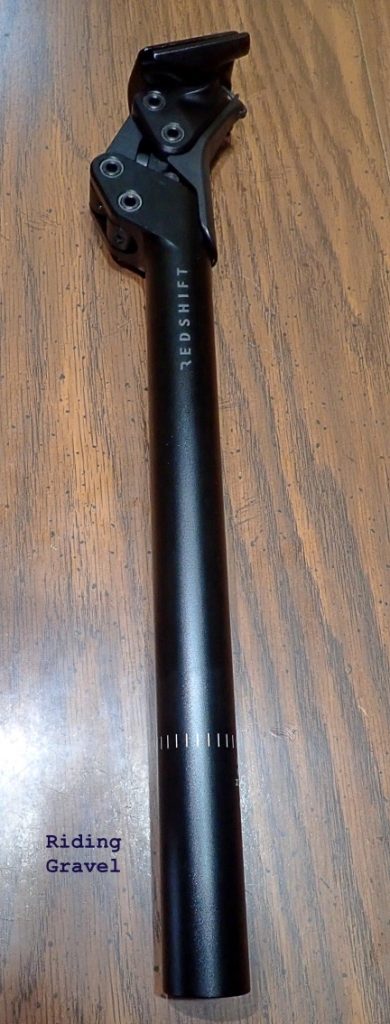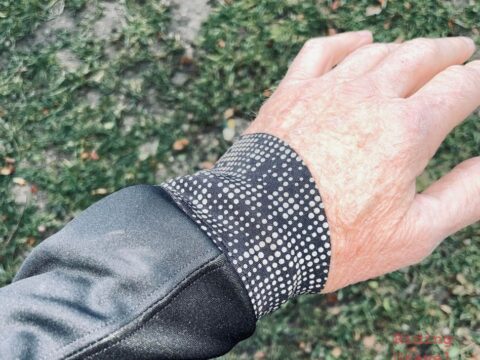Redshift Sports ShockStop Pro Seat Post: Getting Rolling – by Guitar Ted
Almost two years ago, (Already?!!), we reviewed the Redshift Sports ShockStop Seat Post. Today we are introducing the “Pro” version of that post. Two years ago we said that this post was “a game changer” in terms of rider comfort and control. Sure, the post was heavy, but we felt it was worth it from the standpoint of keeping a rider fresh over a long ride.

Redshift Sports could have kept on doing what they were doing and could have considered the ShockStop Seat Post a success, but they didn’t. They went straight away in to finding ways to improve upon the idea and what they came up with is an interesting take on the original theme. While the ShockStop Pro Seat Post may look nearly identical to its predecessor, it is in fact radically different, and it serves a bit different purpose than the original Redshift Sports seat post, in my opinion.

What It Is: Cyclists are always seeming to be chasing after ways to lighten up their bicycles. So, when the ShockStop Seat Post debuted and we weighed it in at 557 grams, many of you readers were turned off by that immediately. Of course, a standard aluminum seat post weighs half as much, or less. But again- we believed – and still do – that the weight of the Redshift Sports post is acceptable for the comfort and control gains. However; that didn’t stop Redshift Sports from trying some things to lighten up the post, and what we have here are the results of their efforts.
Visually you can see how the pivot axles are now hollowed out. The parallelogram bits are trimmed down, and they do not rest up against each other as a result. But internally is where the Pro version takes a hard turn away from the original post.
Gone are the coil springs and adjustment dial at the bottom of the shaft of the seat post. In place of a steel coil spring, Redshift Sports went with the elastomer material which they employ to great effect in their popular ShockStop Stem. There also is no user adjustable spring rate. Redshift claims that the elastomer chosen will cover “95% of riders” needs out there and if not, to contact them to “please reach out to support@redshiftsports.com.” Elsewhere the site informs us that, “The progressive spring rate allows us to use a standard elastomer configuration that adapts to the full range of riders and eliminates the need for adjustable preload.” Redshift Sports says this elastomer choice is “Race Tuned” for elimination of buzz but a choice in spring which still is supportive of rider’s pedal forces for maximum power transfer.
So, there is a compromise from what you have in terms of adjustability in the original post, but Redshift Sports claims that this Pro version should feel firmer under power and be a simple “set it and forget it” post which will reduce vibrations and thus- fatigue for the rider. Also worth noting: Because of the spring change and redesign internally, this Pro version has 10mm less travel than the original ShockStop Seat Post. The Pro post has 20mm of what Redshift Sports claims is “progressive travel”. Redshift Sports offers the ShockStop Pro Seat Post in two lengths- 280mm and 350mm. We have the 350mm on test. Retail price for the Redshift Sports ShockStop Pro Seat Post is $299.99USD.


First Impressions: Out of the box I could immediately feel the lighter weight of this Pro version of the post over the standard version. The hollowed out pivots were noted next. Otherwise, detecting the other differences required a side-by-side comparison. The look is subtly different, but the over all look is definitely similar. The only dead giveaway that a rider would have the Pro version being the hollow pivots.
Then I noted that there were no “guts” visible. The lack of springs in the Pro version means that the weight of the post is concentrated at the parallelogram end. Our sample came in at 422 grams, by the way, a full 135 grams lighter than our previous ShockStop post. But other than that, this post seems to be of the same high quality that I have come to expect from Redshift Sports products. The anodization is smooth and rich looking. The details from the graphics carry over from the original post, so all the hash marks and branding look great.
The lack of an adjuster also means that the post’s spring rate is fixed at the factory. Hopefully that agrees with me, (and hopefully most other folks), but that is why we test things. It is an interesting call to make though, as a manufacturer, because you have to know you won’t please everybody.
As with the original ShockStop post, the saddle clamp bolts are easily accessed by pushing the plastic shield aside, which is held in place by a magnet. Also similar was the fussy saddle installment procedure. That makes sense because the Pro post has exactly the same saddle clamp that the original post has. But once you get that out of the way, it is easy to install the 27.2mm post into the frame, set your height, and go. By the way, 27.2mm is the only diameter offered, so if you have need of a smaller diameter post, you won’t be using this one. Larger seat tube ID’s can be accommodated by the use of shims.
I chose to install the Pro ShockStop post into the Black Mountain Cycles MCD model I have since I ran the standard ShockStop post in this bike most of 2021. The saddle height was set and the post clamped in the frame with no issues at all. I then dialed in my saddle tilt using the two-bolt clamp and when I achieved saddle tilt nirvana, I was good to go.
First Ride: I just had time to take a quick spin on the ShockStop Pro post, but it didn’t take long to understand that this will be a completely different experience than I had with the original post which uses a coil sprung suspension as opposed to the Pro’s elastomeric based spring. A coil has very quick reacting suspension with a ‘floaty’, somewhat disc9onnected feel from the road surface. The word ‘suspended’ really describes the coil spring experience well. You know you have that coil spring when you ride the original ShockStop post. The Pro does not impart this feeling at all.

In fact, it is largely transparent in that I had a very difficult time feeling if the post was working at all. (It was) However; the travel was there, it was just so subtle I had a hard time feeling it. Again, that’s a quick first take, and my thoughts are that, unlike the original ShockStop post, this Pro version supports in the saddle pedaling more and in a better way. More to come on how this post rides after I get some gravel time in on it.
So Far… The Redshift Sports ShockStop Pro Post is a very similar looking seat post to their first offering, but ‘under the hood’ things are a bit different. Gone is the super-supple coil spring and in its place is a firmer feeling elastomeric substitute. But that isn’t all. Redshift Sports lightened up the pivot axles, shaved down some of the aluminum bits, and in the process made the Pro version here 130+ grams lighter.
I’ll be back in a month or so after the weather breaks with my initial thoughts on the performance on gravel roads with the “Checkpoint” update.
For more on the Redshift Sports ShockStop Pro Seat Post see the webpage for the post here: https://redshiftsports.com/products/shockstop-pro-suspension-seatpost-rt
Note: Redshift Sports sent over the ShockStop Pro Seat Post for test and review at no charge to Riding Gravel. We were not paid, nor bribed, for this review and we will always strive to give our honest thoughts and views throughout.











I’m very interested to see how you find the “one size fits all” elastomer. In my own experience, and seemingly that of many other folks, the recommended elastomer strength for the redshift stem was far too pliant. Only upon going to a much more resistant setup did it agree with me (I love the thing).
I’m currently torn between the two posts, as I do care quite a bit about weight but am nervous that the pro won’t outperform something like the much-lighter eesilk or new eesilk+. I’m hoping that the pro is in fact that middle ground and look forward to your early returns.